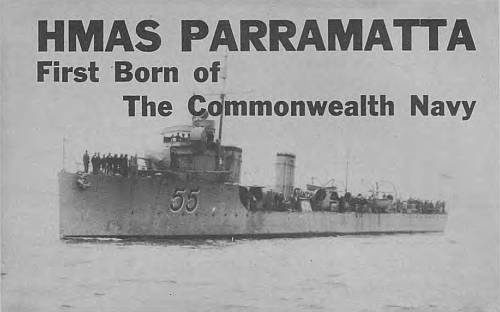- Author
- A.N. Other and NHSA Webmaster
- Subjects
- Ship histories and stories
- Tags
-
- RAN Ships
- HMAS AE1, HMAS Huon I, HMAS Warrego I, HMAS Yarra I, HMAS Swan I, HMAS Torrens I, HMAS Australia I, HMAS Parramatta I
- Publication
- September 1974 edition of the Naval Historical Review (all rights reserved)

The torpedo boat destroyer, HMAS Parramatta, was born of political expediency and twenty years later was saved from scuttling by political expediency. The first ship built for the Royal Australian Navy was also the longest lived. To her laurels is the credit of sinking the RAN’s first U-boat.
THE STORMIEST ISSUE in Australian politics in 1908 was national defence, and particularly naval defence. Prime Minister Deakin, under attack from the Opposition for his failure to present an acceptable defence policy, included an amount of £250,000 in the budget of that year for the purchase of naval vessels. Deakin, however, was not to spend the money provided because later in that year he was swept from power by a Labor government led by Fisher.
Some weeks after assuming office Fisher ordered the Commander of Commonwealth Naval Forces to produce plans for three destroyers capable of operating at sea. Creswell was prepared for the task. He ordered his staff to modify the plans of a Royal Navy torpedo boat destroyer and within three weeks he presented the completed plans to the Government.
A month after the plans were approved, orders had been placed in the United Kingdom for the three ships. The winning tenders were within the allocation of £250,000 and Parramatta, complete with armament and stores, was ordered from Fairfields of Govan, Scotland, for £82,500. She was the cheapest ship ever built for the RAN.
Laid down on March 17 1909, the vessel was launched on February 9 1910 by Mrs. Asquith, wife of the British Prime Minister. Mrs. Asquith said: ‘First born of the Commonwealth Navy – I name you Parramatta. God bless you and those that sail in you.’ The bottle of champagne broken across the ship’s bows was the first ever exported from Australia.
Trials commenced in June and Engineer Commander Barnes reported her to be a fine ship. Her best speed recorded was 29.6 knots – 2 knots better than specified.
The ship was commissioned by Captain Tickell on September 10, and on the 19th of that month she sailed from Portsmouth for Australia – the first King’s Ship to sail from that port without a rum cask. The Australian Government had decided their navy would be dry.
Parramatta and her sister ship, Yarra, arrived at Broome on November 16 and commenced a round of welcomes which has never been surpassed. The Melbourne Age dubbed them the ‘Lion’s Cubs’, a name which the RAN was to retain until the end of World War I.
When the signal to prepare for hostilities with Germany was received on August 1 1914, Parramatta was undergoing a refit at Garden Island. Within 24 hours her Captain, Lieutenant W. H. F. (Cocky) Warren, was able to report his ship ready for sea. Her first task was acting as a tanker conveying oil from Berrys Bay to the flagship, HMAS Australia, at No.1 Buoy.
The ship sailed north and arrived at Townsville on August 5. The crew were turned to painting the ship black and preparing the vessel for war. She rendezvoused with the fleet at Rossel Island on the 9th, where Lieutenant Warren boarded the flagship for orders for an attack on the German Pacific Fleet in Rabaul Harbour on the night of August 14.
As the destroyers steamed past Australia to head north, three cheers rang out from the flagship. Then, as the last cheer died away, a black-faced stoker in Parramatta poked his head through a hatch and roared: ‘Cheer, you buggers. I’d cheer too if I was on a bloody big ship like yours.’ The comments of the Captain were not recorded.

Time and place decides glory and had the time and place been right on the night of August 14 the names of Parramatta, Yarra and Warrego would have won a place in the annals of the Navy’s great. At 2100 on that night the three destroyers slipped into the darkened harbour of Rabaul to carry out a torpedo attack on Admiral Von Spee’s squadron of two heavy and three light cruisers. Unfortunately, Australian intelligence was at fault and the German fleet was hundreds of miles north of Rabaul – the harbour was empty.
After this abortive attack on Rabaul the fleet sailed to Suva to intercept the enemy, but again the time and place was not right.




